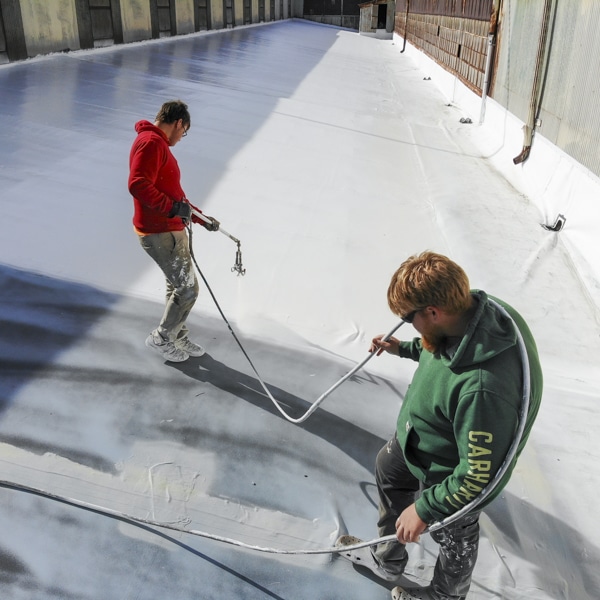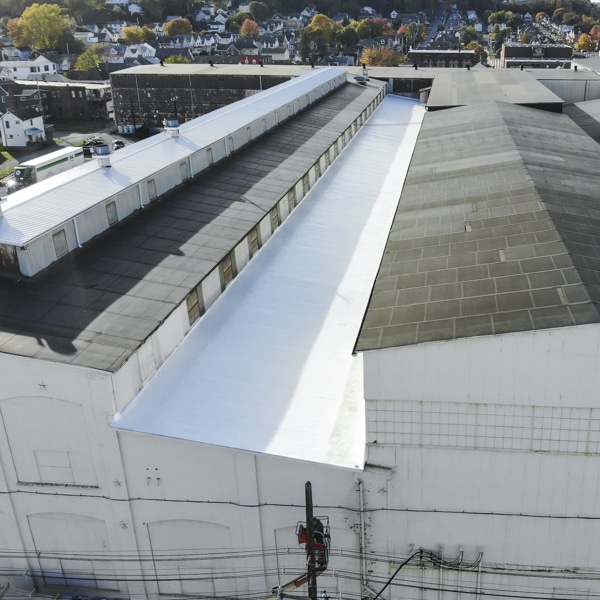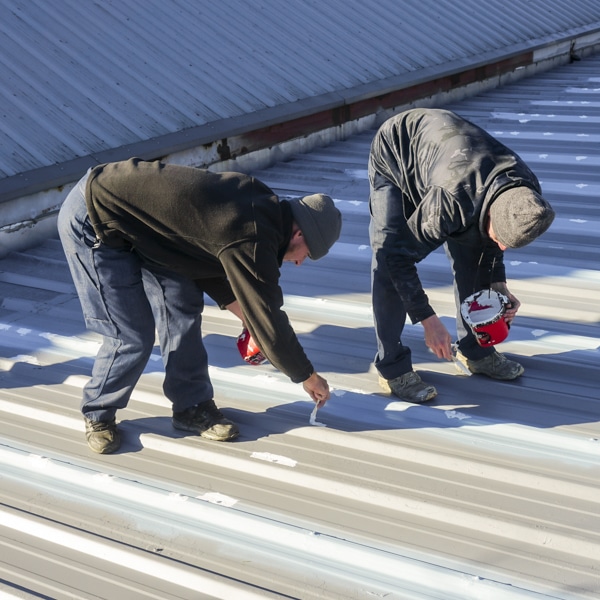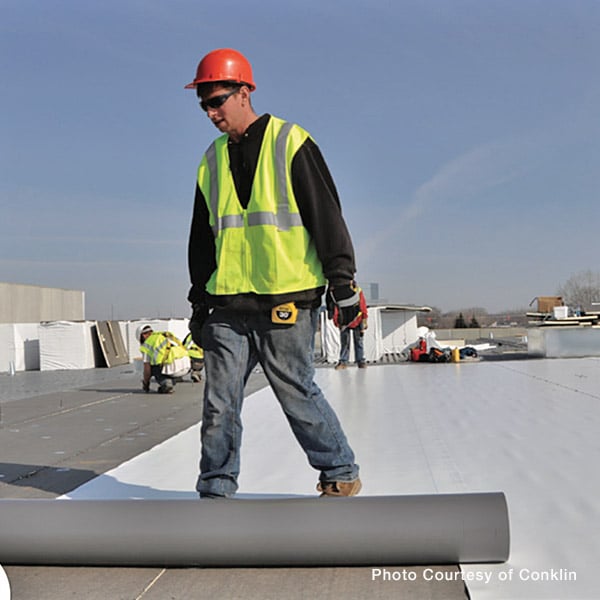Single-Ply Roofs
Flexible thermoplastic membranes are frequently used to construct single-ply roofs, as they can be rolled out and fastened to the roof deck. These roofs are highly favored by numerous commercial building owners and developers due to their cost-effectiveness, durability, and ability to create a watertight low slope roofing system. By employing a wider width, these membranes minimize the number of seams, which are typically prone to causing roof leaks. This characteristic sets them apart from other rolled roofing materials such as asphalt, providing a clear advantage.
Lester’s Carpentry, located in Pennsylvania, is assisting commercial building owners in avoiding the necessity of future roof tear-offs and replacements. This is accomplished by utilizing Conklin’s single-ply roof coating system. This system incorporates a robust and energy-efficient design, featuring a unique chemical formulation called Flexion® Elvaloy®-modified PVC, renowned for its remarkable strength and performance. Applying this coating system on commercial buildings with concrete, steel, or wood roofing decks provides significant value. It may very well be the final installation or replacement your facility will ever require for its commercial roof.
Avoid Expensive Tear-Offs for Single-Ply Roofing
Despite the high durability of many single-ply roofs, the passage of time, humidity, and severe weather conditions can weaken the surface, making it vulnerable to moisture, dirt, and debris. These factors can lead to roof leaks and water-related damage, potentially impacting both the roof structure and the contents inside. Typically, in such situations, the old roofing materials are removed to install a new membrane.
Our Single-Ply Roof Membrane and coating system offers a solution by being installed directly on top of an existing roof deck. It can also serve as a long-lasting, durable membrane for new roof installations. By periodically recoating with our seamless coating system, you can effectively repair, protect, and preserve your Flexion® and other approved membranes. This process virtually eliminates the need for expensive tear-offs and roof replacements in the future, as long as you own the building.

Enhanced Protection Against Water, Hail, Wind & Fire
The Conklin Single Ply Roofing System features an exceptional solar reflective elastomeric waterproof membrane coating that offers robust and reliable protection against various seasonal weather and environmental conditions, such as rain, hail, wind, and fire. Furthermore, it effectively resists dirt and discoloration, ensuring years of enduring, low-maintenance performance.
Lower Utility Costs with “Cool Roof” Energy Efficiency
Conklin’s white reflective single-ply membrane and coating system utilize advanced “cool roof” technology, surpassing other reflective surfaces by reflecting 84 percent of the sun’s UV radiation. This remarkable performance results in high energy efficiency and significantly cooler indoor spaces. Beyond the benefits of improved HVAC performance, business owners in Pennsylvania can save up to 30% in cooling costs during the hot summers. Moreover, your business may qualify for tax credits, utility rebates, and additional incentives that can offset the investment in your roofing system. Many satisfied customers have experienced the system paying for itself within the warranty period. Conklin’s single-ply membrane and coatings are recognized by the EPA’s EnergyStar program and rated by the Cool Roof Rating Council (CRRC).
Single-Ply Coating System Advantages
In summary, when Lester’s Carpentry installs Conklin’s single-ply coating system on commercial buildings in Pennsylvania with low-slope roofs, it provides a highly durable and weather-resistant roofing solution. This system offers long-lasting performance and a lower total lifecycle cost that surpasses many other commercial roofs. By choosing this exceptional option, business owners, property managers, and facility managers can effectively avoid the need for future tear-offs and replacements.
- Superior waterproofing protection stops and eliminates leaks on single-ply roofs.
- Exceptional weather resistance to wind and hail.
- High solar reflectivity protects the roof from UV radiation and discoloration.
- High energy efficiency reduces utility costs all year long.
- Renewable coating virtually eliminates costly tear-offs and roof replacements.
- EnergyStar, Cool Roof Rating Council (CRRC) rated, and FM Approved.
- Long-term 20-year non-prorated and extendable warranty is available.

Single-Ply Roofs Need Advanced Coating System Installation in Pennsylvania
Lester’s Carpentry’s single-ply roof coating system can restore and protect your existing concrete, steel, or wood roof deck and approved membranes, virtually eliminating the need for future roof replacements. For a limited time, we are offering FREE roof inspections for agricultural, industrial, and commercial buildings in Rossiter, Ebensburg, Altoona, Claysburg, and surrounding communities in Pennsylvania. Call to schedule an appointment for a free estimate today.
Types of Single-Ply Membranes
Single-ply roofing membranes are a popular choice for commercial buildings due to their durability, flexibility, and ease of installation. These membranes come in three main types, each offering unique benefits based on the needs of the building:
-
TPO (Thermoplastic Polyolefin):
- Known for its highly reflective white surface, TPO reduces energy costs by reflecting sunlight, making it an energy-efficient choice.
- Resists UV radiation, reducing degradation from sun exposure over time.
- Offers strong chemical resistance, making it suitable for roofs exposed to oils, greases, or other chemicals.
- Often used in warm climates where cooling costs are a concern.
-
PVC (Polyvinyl Chloride):
- Highly durable and flexible, PVC membranes withstand extreme weather conditions and mechanical stress.
- Exceptional chemical resistance makes them ideal for environments where the roof may come into contact with harsh substances.
- Offers fire resistance, providing additional safety for certain types of commercial buildings.
- Excellent for projects requiring a long-lasting and versatile roofing solution.
-
EPDM (Ethylene Propylene Diene Monomer):
- A rubber-like material known for its outstanding resistance to weathering, UV rays, and ozone exposure.
- Often chosen for colder climates due to its black surface, which absorbs heat and can help melt snow or ice.
- Highly flexible, allowing it to withstand temperature fluctuations and minor building movements.
- Cost-effective and easy to maintain, making it a practical option for many commercial applications.
Each type of single-ply membrane has specific advantages, so selecting the right material depends on factors like climate, building usage, and energy efficiency goals.
Advantages of Single-Ply Roofing
Single-ply roofing is a popular choice for commercial buildings, offering numerous benefits that make it a reliable and versatile roofing solution:
-
Lightweight Design:
- Reduces the structural load on the building, making it suitable for both new constructions and retrofits.
- Minimizes the need for additional structural reinforcements, saving time and costs during installation.
-
High Durability:
- Resistant to UV radiation, preventing degradation from prolonged sun exposure.
- Offers excellent resistance to chemicals, making it ideal for environments like industrial facilities or restaurants.
- Durable against environmental factors such as wind, hail, and temperature fluctuations.
-
Energy Efficiency:
- TPO and PVC membranes feature reflective white surfaces that reduce cooling costs by reflecting sunlight.
- Contributes to creating energy-efficient buildings, helping to meet sustainability goals and potentially qualify for green certifications.
-
Versatile Installation Methods:
- Mechanically Attached: Fastened with screws and plates, suitable for high-wind areas.
- Fully Adhered: Secured with adhesive, providing a smooth appearance and excellent performance.
- Ballasted: Held in place with stones or pavers, offering a cost-effective and quick installation option.
-
Flexibility and Ease of Installation:
- Adapts to different building types and climates, providing solutions for both flat and low-sloped roofs.
- Quick and straightforward installation minimizes downtime and disruption to building operations.
-
Popularity for Commercial Applications:
- Widely used due to its balance of cost-effectiveness, performance, and longevity.
- Compatible with a variety of insulation types, further enhancing its adaptability.
Single-ply roofing combines lightweight efficiency, durability, and flexible installation, making it a trusted choice for commercial buildings in diverse industries.
Installation Process of Single-Ply Roofing
Single-ply roofing systems can be installed using three primary methods, each tailored to specific building needs and conditions:
-
Mechanically Attached Systems:
- Use fasteners and plates to secure the membrane directly to the roof deck.
- Provides a quick and cost-effective solution, especially for large commercial projects.
- Ideal for buildings in moderate wind zones due to its secure attachment.
- Allows for easy inspection and maintenance since the membrane is not glued or weighed down.
-
Fully Adhered Systems:
- The membrane is bonded to the roof deck using specialized adhesive, creating a seamless and smooth appearance.
- Offers superior resistance to wind uplift, making it suitable for taller buildings or high-wind areas.
- Provides excellent insulation compatibility, enhancing energy efficiency.
- Requires a clean and properly prepared surface for optimal adhesion and performance.

-
Ballasted Systems:
- Involves loose-laying the membrane and holding it in place with heavy materials like gravel, stone, or concrete pavers.
- Cost-effective for large, flat roofs with minimal slope.
- Offers additional thermal and sound insulation due to the ballast material.
- Best suited for buildings with strong structural support to bear the additional weight.
Factors Influencing Installation Method
- Building Height: Taller buildings often benefit from fully adhered systems due to their wind resistance.
- Wind Exposure: Mechanically attached and fully adhered systems are better for areas with high wind exposure.
- Budget: Ballasted systems are generally more economical but may not be suitable for all roof structures.
The flexibility in installation methods ensures that single-ply roofing can adapt to various building designs, climates, and performance requirements.
Maintenance and Repair
Single-ply roofs are relatively easy to maintain, especially TPO and PVC systems, which have heat-welded seams that reduce the risk of leaks. Regular inspections are essential for identifying damage such as punctures, tears, or seam separations. When repairs are needed, they can be easily completed by patching or re-welding seams. Maintaining a roof ensures long-term durability, and the low-maintenance nature of these roofs helps reduce overall costs. Consistent inspections and minor repairs help prolong the roof’s life and keep it performing efficiently.
Lifespan
The typical lifespan of a single-ply roofing system ranges from 20 to 30 years, depending on the material, installation quality, and maintenance. TPO and PVC are particularly durable, resisting UV radiation, chemicals, and weather extremes, making them ideal for long-term protection. Regular maintenance and inspections can help extend the life of your roof. Compared to other roofing materials, this roofing offers a good balance of longevity, ease of maintenance, and affordability, making it a popular choice for commercial and industrial applications.
Common Applications
Single-ply roofing is commonly used in commercial and industrial buildings with flat or low-slope roofs, such as warehouses, shopping centers, and factories. Its lightweight nature and adaptability make it ideal for large structures. These roofs are also frequently used in green roofing systems, where the membrane serves as a waterproof barrier beneath vegetative layers. The energy efficiency of TPO and PVC membranes makes them popular in climates where cooling costs are a concern, while EPDM is often used in colder climates for its heat-absorbing properties.

Cost-Effectiveness
Single-ply roofing is considered cost-effective due to its relatively low installation costs and long lifespan. TPO, PVC, and EPDM systems offer flexibility in terms of installation methods, which can reduce labor time and costs. Additionally, the durability and low maintenance requirements of these roofs contribute to long-term savings. The energy efficiency of TPO and white PVC roofs can further lower building cooling costs, making them a smart investment for businesses. With proper maintenance, a single-ply roof can offer excellent value over its lifetime, making it a preferred choice for commercial buildings.
UV and Heat Resistance
Single-ply roofs are known for their UV and heat resistance. TPO and white PVC membranes are especially reflective, reducing heat absorption and lowering cooling costs in hot climates. These reflective properties make this roofing ideal for energy-conscious buildings looking to improve efficiency. On the other hand, EPDM, with its black surface, absorbs heat and is more suited to colder climates where additional warmth is beneficial. This versatility in handling UV and heat exposure allows single-ply roofing systems to be tailored to different environmental conditions, enhancing building performance.
10 FAQ’s About Single-Ply Roofing
What is a single-ply roof?
A single-ply roof is a flat or low-slope roofing system made of flexible, synthetic membrane materials, such as TPO (Thermoplastic Polyolefin), PVC (Polyvinyl Chloride), or EPDM (Ethylene Propylene Diene Monomer). These membranes are installed in a single layer and are commonly used in commercial buildings due to their durability, energy efficiency, and ease of installation.

How long do single-ply roofs last?
A single-ply roof typically lasts between 20 to 30 years, depending on the material, installation, and maintenance. However, by applying Conklin’s roof coatings, you can extend the lifespan of your roof by up to 20 years. Conklin’s coatings provide additional protection against UV radiation, weathering, and environmental damage, restoring the roof’s surface and sealing any minor leaks or damage. Regular inspections and the use of such coatings not only prolong the roof’s durability but also enhance its performance, making it a smart choice for long-term roofing solutions.
What are the advantages of single-ply roofing?
Single-ply roofing offers many advantages, including durability, UV resistance, and energy efficiency. TPO and PVC membranes are highly reflective, helping reduce cooling costs, while EPDM is known for its weather resistance and durability. These roofs are also lightweight, reducing the structural load on buildings. Additionally, the ease of installation and low maintenance requirements make single-ply roofs cost-effective and practical for commercial applications.
How is a single-ply roof installed?
Single-ply roofing systems can be installed using three main methods: mechanically attached, fully adhered, or ballasted. In mechanically attached systems, fasteners secure the membrane to the roof deck. Fully adhered systems use adhesives to bond the membrane to the surface, while ballasted systems involve loose-laid membranes held down by heavy materials like gravel or pavers. The installation method depends on the building’s structure, height, and exposure to wind.
Are single-ply roofs energy-efficient?
Yes, single-ply roofing systems, especially those using TPO and PVC membranes, are highly energy-efficient. These materials have reflective surfaces that help reduce heat absorption, leading to lower cooling costs in hot climates. White TPO and PVC membranes reflect sunlight and heat, making them ideal for buildings looking to improve energy efficiency.
What kind of maintenance does a single-ply roof require?
Single-ply roofs are relatively low-maintenance but still require regular inspections to ensure their longevity. Routine maintenance involves checking for punctures, tears, seam separations, and any signs of damage. Timely repairs, such as patching or re-welding seams, can prevent small issues from becoming larger problems. Proper upkeep can help extend the lifespan of your roof and maintain its performance.
Is a single-ply roof waterproof?
Yes, single-ply roofing membranes are designed to be waterproof, providing protection against water infiltration. When properly installed and maintained, these membranes prevent water from entering the building, even in heavy rain or harsh weather conditions. The seams in TPO and PVC membranes are typically heat-welded, creating a strong, watertight seal.
What are the differences between TPO, PVC, and EPDM single-ply roofs?
TPO is known for its energy efficiency and UV resistance, making it ideal for warm climates. PVC offers excellent chemical and fire resistance, which is useful in industrial settings. EPDM, a rubber-based membrane, is highly durable and weather-resistant, and it’s commonly used in colder climates because of its heat-absorbing black surface. Each material has unique strengths, and the choice depends on specific building needs and environmental factors.
Can single-ply roofs be installed over existing roofing?
In many cases, a single-ply roof can be installed over an existing roofing system, provided the current roof is in good condition and meets local building codes. This process, called re-roofing or retrofitting, can save time and costs by eliminating the need for a full roof removal. However, an inspection should be conducted to ensure the structural integrity of the underlying roof.
How much does a single-ply roof cost?
The cost of a single-ply roof depends on various factors, such as the type of membrane, roof size, installation method, and location. On average, these roofing systems are cost-effective compared to other options due to their durability and low maintenance requirements. Though upfront costs may vary, the long-term energy savings and extended lifespan of a single-ply roof make it a financially sound investment for many building owners.
